Affordable Engagement Ring Buying Strategies
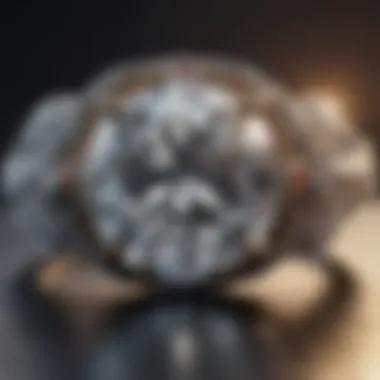
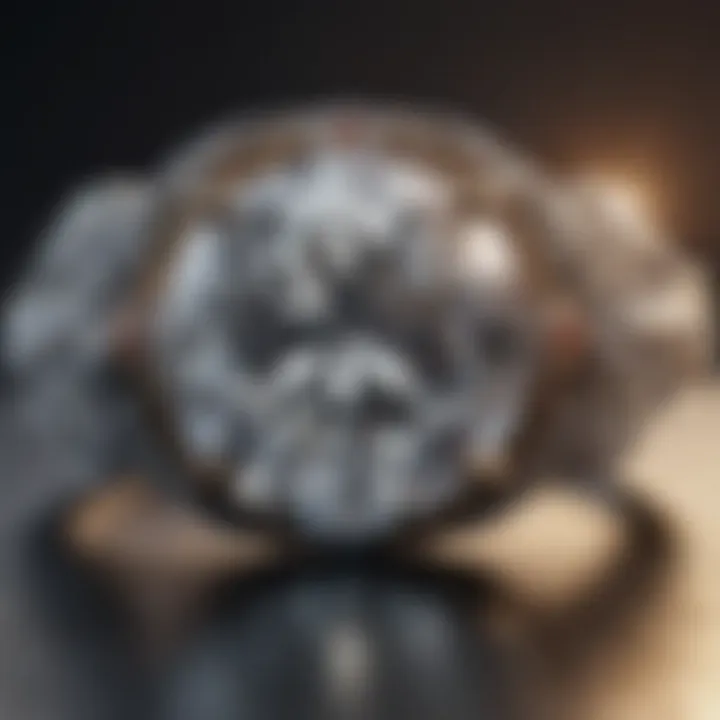
Intro
Finding an engagement ring that beautifully combines quality and affordability can feel like searching for a needle in a haystack. There's an undeniable pressure to present a significant piece of jewelry that symbolizes love and commitment, yet the reality of budgets can’t be ignored. Understanding the intricacies of gemstones, market trends, and personal preferences is essential for making an informed choice without breaking the bank.
Gemstone Overview
Definition and Characteristics
Gemstones are natural or synthetic materials that are often cut and polished for use in jewelry. Each type of gemstone holds its unique characteristics that influence its appeal and price. For instance, diamonds are coveted for their brilliance and hardness, but alternatives like moissanite or lab-grown diamonds are gaining traction due to their cost-effectiveness and ethical considerations. When selecting a gemstone, consider factors such as:
- Color: The hue of a gemstone not only affects its beauty but also its value.
- Clarity: This refers to the absence of inclusions or blemishes, which can impact visual appeal.
- Cut: The shape and facets can enhance a gemstone’s sparkle, making it more desirable.
- Carat Weight: Larger stones are often more valuable, but don’t overlook smaller, high-quality options.
Classification of Gemstones
Gemstones can be broadly categorized into precious and semi-precious stones. Precious gemstones like diamonds, rubies, sapphires, and emeralds are traditionally valued higher due to their rarity and durability. Meanwhile, semi-precious stones, including garnets and amethysts, offer beautiful alternatives at more accessible price points.
- Precious Stones: Diamonds, Rubies, Sapphires, Emeralds
- Semi-Precious Stones: Amethyst, Garnet, Citrine, Topaz, Aquamarine
"The beauty of a gemstone lies not just in its appearance but also in the emotions and stories it embodies."
Historical Significance
Ancient Uses and Cultural Importance
Throughout history, gemstones have played a significant role in various cultures. Ancient Egyptians believed in the protective qualities of turquoise, while the Greeks associated sapphires with wisdom and nobility. Even today, many people choose gemstones based on their historical meanings
- Turquoise: Protection and communication
- Sapphire: Wisdom and nobility
- Emerald: Love and rebirth.
Myths and Legends Surrounding Gemstones
Every gemstone comes with its own narrative, often shrouded in myths and legends. For example, the deep red hue of rubies is said to symbolize passion and life. In some cultures, wearing a garnet is believed to bring safety during travel. These stories can add an extra layer of significance when choosing a stone, making it not just a piece of jewelry, but a token of tradition and belief.
In summary, understanding the attributes of gemstones not only helps in selecting an affordable engagement ring but also connects the buyer to a rich tapestry of history and meaning. By appreciating these finer details, you can make a well-rounded decision that reflects love, intent, and budget.
Prelims to Affordable Engagement Rings
The journey to find the perfect engagement ring is often a path filled with aspirations, emotions, and, of course, financial considerations. This segment serves as a crucial touchstone within our broader discussion on securing an affordable engagement ring. Understanding that an engagement ring symbolizes commitment and love, one may quickly forget the practical aspects tangled up in this significant purchase.
Embracing the notion of affordability doesn’t mean skimping on quality or significance. It means recognizing the value beyond the price tag. A well-chosen ring reflects not just the personality of the wearer but also the backstory of the relationship. When budget constraints come into play, it’s vital to approach the process with both heart and head.
Considering the myriad of options available today, from traditional diamond rings to sleek and modern alternatives, prospective buyers are no longer limited by conventional choices. The meaningfulness of the ring does not have to correlate directly with its cost. The affordability narrative becomes even clearer when one digs into the cultural importance of engagement rings.
A practical tip at this juncture is to keep an open mind. For example, opting for a smaller carat weight or exploring different gemstones can save some serious dollars while still resulting in a stunning ring. Minor adjustments can yield massive savings without sacrificing aesthetic appeal or emotional value.
Ultimately, this section aims to spotlight the various strategies and available paths to navigate the engagement ring market intelligently. We will delve into the cultural significance of these symbols of love and commitment, followed by a closer examination of contemporary trends that could guide budget-savvy purchasers.
The Cultural Significance of Engagement Rings
Engagement rings are steeped in history and cultural relevance. Traditionally, they symbolize a promise of marriage, acting as a public declaration of a couple's intent to commit to one another. Different cultures place various meanings on rings, sometimes linking them with specific materials or designs that celebrate their customs.
For instance, in many Western cultures, diamonds represent the ideal choice, championed by De Beers’ famous marketing of the mid-20th century. Yet, this tradition isn't universal. In some cultures, colored gemstones — like sapphires or emeralds — are favored, often believed to bring good luck and prosperity into the marriage.
"An engagement ring is more than a piece of jewelry; it carries the weight of promises, emotions, and dreams."
Furthermore, the symbolism of the ring can also evolve, reflecting the values and priorities of modern couples. Many young individuals today view ethical sourcing, sustainability, and personalized stories as crucial facets when selecting their rings. Thus, as consumers embrace varied ethical considerations, they often lean towards alternative gemstones which may be more socially conscious.
Understanding Engagement Ring Trends
While cultural significance plays a central role, staying abreast of current trends is equally vital in making an informed purchase. The engagement ring market has seen a shift in preferences. One of the most notable trends is the rise in popularity of non-diamond options. This change often springs from a desire for unique representations of individuality and personal taste.
For instance, vintage rings have made a significant comeback. Couples are attracted to the charm and character of a unique, vintage piece, reflective of a bygone era yet still steeped in contemporary significance. Additionally, trends toward intricate settings and unconventional shapes enhance originality; the one-size-fits-all mentality is progressively set aside in favor of more tailored choices.
Emerging styles, such as minimalist designs, offer a fresh take, prioritizing simplicity and elegance without compromising on beauty. As these trends resurface, potential buyers can find exceptional value in rings that are not necessarily tied to traditional diamond expectations, increasing opportunities for affordability.
Setting a Realistic Budget
Setting a realistic budget for an engagement ring is like laying the foundation for a house. It's crucial to ensure that everything built afterward stands strong. A budget not only dictates the purchasing power but also influences the quality of the ring one can acquire. Without a thoughtful budget, a buyer risks falling into emotional purchases or sales traps, which can lead to regret down the road.
Having a budget in mind allows couples to prioritize their needs and desires—what features matter most to them in a ring? Are they leaning towards a diamond or considering alternatives? Also, understanding specific financial constraints takes a significant weight off one’s shoulders, preventing haphazard spending sprees.
Assessing Financial Priorities
Before diving into the vibrant world of jewels, it's wise to take a step back and evaluate financial priorities. This step isn’t just about numbers; it's about values. Are you saving for other life events like a home, travel, or perhaps future children's needs? Knowing what you want in the bigger picture can influence how much you might want to allocate for an engagement ring.
It's also a moment to reflect on existing debts. For instance, if one carries student loans or credit card bills, factoring those in is crucial. By identifying what’s most important, couples can gauge a reasonable amount to spend without putting a strain on their finances.


Allocating Funds for Different Aspects
When talking about allocating funds for different aspects of an engagement ring, think of it as budgeting for a gourmet meal. You wouldn’t spend all your money just on an exquisite appetizer and neglect the main course! Similarly, when it comes to an engagement ring, it’s vital to spread the funds thoughtfully across several essential areas.
Evaluate Monthly Savings
Evaluating monthly savings means taking a good hard look at your current spending habits. Do you find yourself grabbing takeout a couple of times a week? Maybe you can swap it for some home-cooked meals to pocket a bit of that cash to go toward ring savings.
By setting a monthly savings goal, you can steadily work toward that end amount without feeling the pinch. Aligning your spending with your savings makes the process manageable and even satisfying. Plus, it fosters a sense of discipline that can only be a boon in other financial endeavors.
Consider Expenses and Future Investments
Considering expenses and future investments is like checking the mirrors before switching lanes while driving—crucial for safe passage. Here, it’s paramount to look at not just the ring but everything that comes along with it: wedding costs, living arrangements, and potential future kids can all play into this picture.
This aspect demands attention to essential spending areas. It’s also about foreseeing situations where you might encounter unexpected costs—car repairs, health expenses, and other life surprises can pop up without a moment's notice. Making ample space in your budget for these factors ensures that both your engagement ring purchase and future financial well-being are well taken care of.
"Setting a budget is about more than numbers; it’s about building a future together."
In summary, establishing a realistic budget is a critical first step. By assessing financial priorities and allocating funds wisely, couples can take control of their spending while purchasing an engagement ring that resonates with both hearts and wallets.
Exploring Diamond Alternatives
When embarking on the journey of selecting an engagement ring, particularly when keeping an eye on the budget, exploring diamond alternatives is not just a sensible choice, but also a liberating one. The notion that diamonds are the only suitable engagement ring stone is rapidly changing, thanks to increased awareness around alternatives that offer both beauty and value without axing your savings. This section delves into crucial alternatives like moissanite and various gemstones that can enhance the significance of your ring while being wallet-friendly.
Choosing Moissanite Over Diamonds
Moissanite has emerged as a game-changer in the engagement ring industry. Many shoppers are drawn to it due to its remarkable resemblance to diamonds yet at a fraction of the cost. One of the most compelling aspects of moissanite is its brilliance; it actually reflects light more vividly than diamonds. This means that when you pop the question, it’s likely that the ring will sparkle like no other.
Additionally, moissanite is a sustainable option, originating from natural materials or created in labs, so it caters to environmentally conscious consumers. However, it’s important to note that while many find the characteristics of moissanite appealing, some traditionalists feel that a diamond holds a symbolic significance that can’t be replicated.
In terms of budget, a moissanite ring can save you anywhere from 50% to 90% in comparison to a traditional diamond ring of equal size and clarity. So if you’re after a dazzling look without draining your finances, moissanite could be your best bet.
The Appeal of Gemstone Engagement Rings
The world of colored gemstones offers a diverse and alluring alternative to the traditional diamond ring. These stones can provide a distinct flavor to your engagement set while also ensuring that your choice stands out from the crowd. Each gemstone carries its own meaning and historical essence that resonates with many couples.
Emeralds
Emeralds have a lush green hue that captivates the eye and symbolizes rebirth and love. A key characteristic of emeralds is their rarity; high-quality emeralds are less common than diamonds, which makes them a unique choice. This uniqueness is a significant attraction for many, as having an emerald ring can signify a connection to nature’s beauty.
However, emeralds also come with their own challenges. They tend to be softer than diamonds, which means they require more care to keep them looking their best. But with the right setting and maintenance, an emerald can become a cherished symbol of your commitment.
Sapphires
On the other hand, sapphires offer a rich palette of colors, but they’re famously known for their deep blue tones. Sapphires represent wisdom and nobility, traits appreciated by many. What many folks might not know is that sapphires are incredibly durable, making them a practical choice for daily wear.
One unique feature of sapphires is their versatility—beyond just blue, they come in pink, yellow, and even colorless varieties, allowing couples to truly personalize their rings. Although they can come at a premium price, they still often fall beneath the cost of a diamond.
Rubies
Rubies, with their intense red hues, symbolize passion and love, making them a fitting choice for an engagement ring. The deep, striking color makes a ruby ring bold and eye-catching. Just like sapphires, rubies are durable, thanks to their hardness, and they maintain their brilliance over time.
While rubies can sometimes be more expensive than other gemstones, their rarity and the emotions they invoke often justify the cost. Notably, a ruby engagement ring is not just a piece of jewelry—it's a statement of deep affection and commitment.
In essence, choosing colored gemstones like emeralds, sapphires, or rubies can redefine what an engagement ring symbolizes. Their beauty and individuality are a thoughtful consideration for couples wishing to express their styles and stories without succumbing to traditional norms.
Exploring these extraordinary options opens a world where love is expressed through uniqueness and personal flair.
Choosing the Right Retailer
Selecting the right retailer for your engagement ring is more than just a transaction; it’s about trust, quality, and, ultimately, making a perpetual commitment to a significant promise. A reputable jeweler ensures that you not only receive a beautiful piece but also that it is fairly priced and genuine. This choice can greatly influence your experience and allow you to feel confident in your purchase.
Identifying Reputable Jewelers
Finding a jeweler who can deliver on quality and trust is paramount. To aid in this endeavor, start by conducting thorough research.
- Seek word-of-mouth referrals from friends and family. Their experiences can be goldmines of information about local jewelers.
- Read reviews on platforms like Google and Yelp for insights into customers' experiences.
- Research any jewelry shops in your locale to see if they have certifications such as the Gemological Institute of America (GIA) or International Gem Society (IGS). This indicates a level of professionalism and knowledge about gemstones.
When you narrow down your list, visiting stores in person can also give you a feel for their customer service. Ask questions about their return policies and warranties. A good jeweler will be transparent and willing to provide answers. Doing so not only empowers you as a buyer but also protects your investment.
The Benefits of Shopping Online vs. In-Store
In today’s digital age, the choice between purchasing online or in-store has become a nuanced discussion. Both channels present unique merits and challenges.
Price Comparison
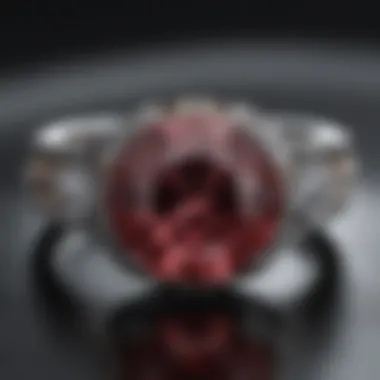
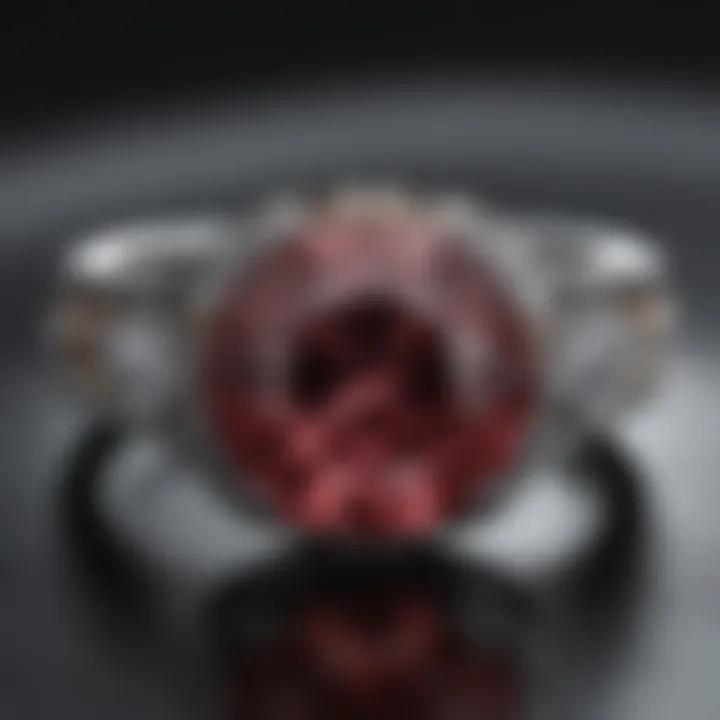
One of the immediate advantages of online shopping is the ease of price comparison. Websites offer a plethora of options that can be viewed and analyzed side by side. This transparency in pricing is a boon for buyers, as it allows you to:
- Identify the best value for your budget by considering multiple retailers.
- Research the prices on various platforms without the pressure of a salesperson looming over you.
However, keep in mind that not all online retailers provide a physical inspection opportunity for their gems. Verify their return policies thoroughly—some may offer flexible returns while others could add hidden fees.
Convenience Factors
The convenience factors associated with online shopping cannot be overstated. It allows you to browse through an extensive selection from the comfort of your home. You can:
- Shop at any hour, regardless of the retail store's location or operating hours.
- Seek out unique gemstone options that might not be readily available locally.
On the flip side, visiting a brick-and-mortar store offers the advantage of tactile experiences, allowing you to feel the quality and see the stone’s brilliance under natural light. You can also benefit from the expert advice of seasoned jewelers, providing you with insights that might not be readily available through online platforms.
"Choosing the right retailer can either elevate your experience or leave you feeling lost; it’s the make-or-break point in this significant investment."
In summary, whether choosing to shop online or in-store, it is essential to weigh the respective pros and cons. Take your time, do your homework, and steer clear of hasty decisions. After all, this engagement ring is a reflection of your love and commitment.
Understanding Gemstone Characteristics
When it comes to engagement rings, knowing about gemstone characteristics is essential for making a well-informed choice that doesn't break the bank. Gemstone qualities greatly influence not only the aesthetics of the ring but also its value and longevity. As you bridge the gap between budget constraints and personal taste, becoming familiar with these characteristics helps avoid any costly pitfalls down the line.
The Four Cs of Gemstone Quality
Understanding the Four Cs—Cut, Color, Clarity, and Carat Weight—is key to finding a stone that suits your needs while remaining within your budget.
Cut
The cut of a gemstone is perhaps its most significant characteristic, as it determines how well the stone reflects light. A well-cut diamond or gemstone can dazzle even if it has less carat weight. The unique feature of this quality is that it can elevate the overall appearance without being overly expensive. For instance, a smaller gem with an excellent cut can appear larger and more radiant than a bigger stone with a poor cut.
However, quality cuts often carry a premium price tag. When budgeting, prioritize cut quality; it's a beneficial choice that enhances the ring's visual appeal without the need for a larger stone. Finding a balance in this aspect can maximize your budget while creating a stunning effect.
Color
The color characteristic refers to the hue of the gemstone, which can influence both its appearance and value. In diamonds, less color is generally preferable; however, colored gemstones provide their own beauty and rarity. For example, vivid blue sapphires or vibrant green emeralds can be more affordable than colorless diamonds in larger sizes, appealing if you seek affordability with personality.
One unique feature of color is its subjective nature—different collectors and wearers appreciate various shades, making these choices personal and distinctive. Remember that while deeper colors can be costly, less intense shades can often serve as budget-friendly alternatives.
Clarity
Clarity focuses on the absence of inclusions and blemishes in the gemstone. Higher clarity stones will generally fetch higher prices, yet, lesser inclusions, when placed strategically, might not be visible to the naked eye. This characteristic's unique feature is that it allows for flexibility; a stone with minor imperfections may still look stunning and offer significant savings. In the realm of jewelrs, a stone with acceptable clarity can have a higher value than an overly scrutinized premium stone.
Carat Weight
Carat weight indicates the weight of the gemstone, which often correlates with its value. However, it's not always the sole determining factor of a stone's worth. A heavier diamond can lack brilliance or sparkle if poorly cut, making the emphasis on carat weight potentially misleading. The unique aspect of carat weight is understanding that a beautifully cut, smaller stone can be equally, if not more, captivating.
For budget-conscious buyers, focusing on value over size is essential; seeking out slightly smaller carat weight stones with superior cuts and clarity can lead to a glorious compromise between budget and beauty.
Evaluating Long-Term Value
When looking at engagement rings and their gemstones, evaluating their long-term value is crucial. Trends come and go, but understanding what makes a stone hold its worth ensures that you’re not just making a purchase, but investing in something that can withstand the test of time.
- Consider the quality of the Four Cs—stones with better quality will generally hold their value better over time.
- Explore market demand; certain colors or types of gemstones may appreciate more than others due to rarity or fashion trends.
Knowing these characteristics helps navigate the waters of affordability while still ensuring that what you choose is meaningful, beautiful, and potentially valuable.
Exploring Customization Options
Customization has become a vital aspect for those searching for an engagement ring that speaks to individual tastes and budget considerations. Tailoring a ring personally allows couples to incorporate their stories, preferences, and styles, forming a piece that is not only a representation of love but also a reflection of who they are. Ultimately, the goal is to find balance—style doesn’t have to come at a premium price if one knows how to navigate the customization waters.
Budget-Friendly Custom Designs
When considering custom designs, it helps to start with a clear budget. Being specific about what you can spend will ensure that you don’t stray into options that are out of reach. Working with local jewelers or even online platforms can lead to significant savings, as they often offer a range of customizable options at various price points.
Taking an approach that focuses on simple yet elegant designs can also reduce costs while still providing uniqueness. For example, a minimalist design can be striking without requiring a large carat size or an abundance of additional decorative elements. You might think about using a unique shape or engraved detail that brings a personal touch without breaking the bank.
Choosing Settings That Fit Your Vision
Choosing the right setting for an engagement ring carries a lot of weight; it informs not only how the stone looks but also how the entire piece is perceived. Below are several popular settings along with their defining characteristics and why they can be great choices for a thoughtful and affordable engagement ring.
Solitaire
The Solitaire setting is a classic, renowned for its simplicity. At its core, this design features a single gemstone prominently displayed. This kind of emphasis allows the quality of the stone to shine. One significant advantage of a Solitaire is that it generally requires less material and crafting time compared to more intricate designs, making it a cost-effective and popular choice. This kind of setting clearly exemplifies sophistication, while still posing excellent options for budget-conscious buyers.
"In matters of style, swim with the current; in matters of principle, stand like a rock." – Thomas Jefferson
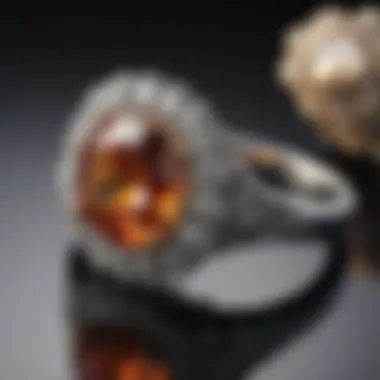
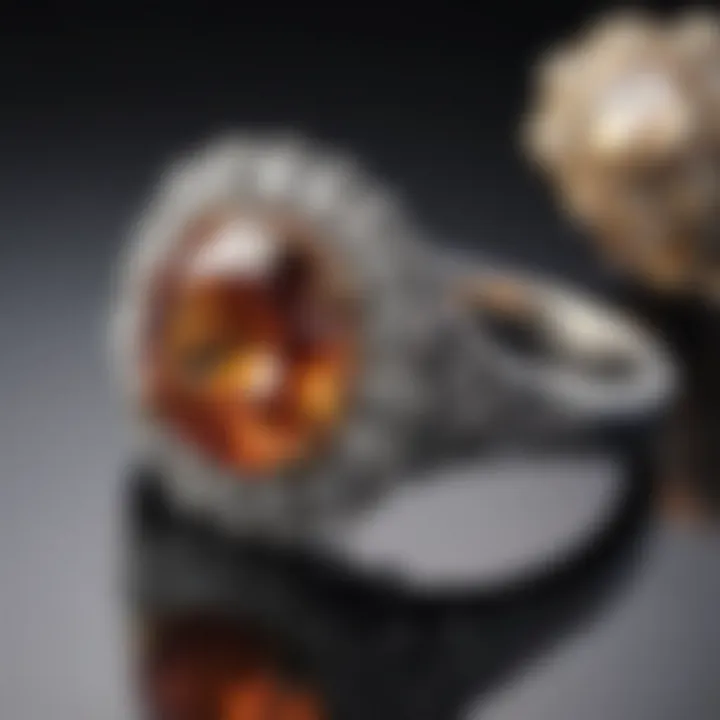
While it highlights the gem beautifully, those who want more sparkle might feel that it lacks additional features. Yet its timeless appeal often outweighs this drawback, allowing couples to focus on the gem itself.
Halo
The Halo setting encapsulates the main stone with a circle of smaller stones, creating a dazzling effect that enhances the overall appearance. Not only does this design magnify the central gem, but it can often make smaller stones appear larger than they are. Because it creates so much sparkle, it gives an impression of extravagance without the associated cost of a larger single diamond.
However, some might see Halo settings as a bit flashy for their taste. Yet, as they say, you either love it or you don't; and for many, that’s precisely the attraction. The design is versatile and allows for various styles of smaller gemstones, making it an appealing option for those inclined toward a bit of color.
Three-Stone
The Three-Stone setting symbolizes the past, present, and future of a relationship, making it a romantic choice. This setting typically features a larger center stone flanked by two smaller stones. This design often captures the emotional essence of engagement beautifully, while simultaneously allowing for the use of different types of stones, creating a unique look.
What makes the Three-Stone setting particularly advantageous is its potential for blending different colored gemstones or even different shapes, giving couples the freedom to express individuality. On the flip side, some may find the three-stone design too busy, and managing a pattern of colored stones might complicate decisions. Still, the ability to mix and mold various designs lends this setting significant appeal for custom engagement rings.
In summary, exploring customization options for engagement rings opens the door to personal touches, budget-friendly alternatives, and unique designs. By carefully selecting the setting and stone style, couples can craft a ring that aligns perfectly with their shared values and personal aesthetics.
Examining the Resale Value
When it comes to purchasing an engagement ring, it is easy to get caught up in the allure of the shiny new object and the emotional weight it carries. However, the resale value is an element that deserves careful consideration. Understandably, one might not want to think about selling something so personal, but circumstances change, and having insight into the potential worth of your ring can provide peace of mind. Knowing that your choice might retain its value or even appreciate over time is an empowering aspect of making a smart investment in an engagement ring.
Factors Affecting Resale Value
Several factors play a role in determining how much you can expect to get back should you decide to part ways with your engagement ring.
- Quality of the Gemstone: One of the foremost elements is the quality of the gemstone. Differentiating between diamonds and alternative stones like sapphires or moissanites can skew the potential resale value. Diamonds often hold a significant portion of their value, particularly if they are certified.
- Market Trends: The jewelry market is subject to changes, much like fashion. What is in vogue today may fall out of favor tomorrow, affecting resale value. Staying informed about current trends can help guide your purchase decision.
- Brand Recognition: A well-known brand can also boost resale value significantly. Rings from established jewelers often command higher prices in the resale market. That being said, individual pieces matter too. A unique or custom design may fetch a better price than a standard model, regardless of the brand.
- Condition of the Ring: The physical state of the engagement ring will largely influence its market value. Well-maintained rings with no obvious signs of wear are likely to yield a better return. Keep your precious piece clean and consider professional servicing when necessary.
"The ring does not just symbolize a commitment. It can also be a financial asset if chosen wisely. "
Potential for Investment in Gemstones
Investing in gemstones has a history that stretches back centuries. While many see engagement rings as mere adornments, they can also serve as a valuable asset. This investment potential will vary based on the type of gemstone and market conditions.
- Emeralds and Sapphires: While diamonds are often thought to be the gold standard for engagement rings, don't discount the other options. High-quality emeralds or sapphires can actually appreciate quite well. Prices on these stones are less predictable but can yield substantial returns under the right conditions.
- Market Analysis: Similar to other investments, the key lies in performing thorough market research before making a purchase. Knowing the historical performance of a specific gemstone and where it's headed can have an impact on whether you choose it for an engagement ring or as an investment.
- Investment Risk: Investing in gemstones does not come without risks. Like any market, the value can fluctuate, and it may take time before it appreciates. Your emotional attachment to an engagement ring may also cloud judgment about its worth as an investment.
To wrap it up, understanding the resale value of an engagement ring calls for keen awareness of various factors. Not only can it safeguard your financial interests, but it can also shape the choices you make during the buying process.
Navigating Market Trends
Understanding market trends is crucial for anyone aiming to acquire an affordable engagement ring. The landscape of jewelry is ever-evolving, influenced by cultural shifts, economic fluctuations, and consumer behavior. Keeping an eye on these trends can not only help in making informed purchases but also enable buyers to snag the best deals available.
Current Trends in the Engagement Ring Market
The engagement ring market is undergoing significant changes, with several trends shaping consumer preferences and buying patterns. One notable trend is the increasing popularity of ethical and sustainable jewelry. More consumers are opting for rings made from conflict-free diamonds or alternative stones like moissanite and lab-created gems. These options often come at a lower price point without sacrificing beauty or quality.
Another trend is customization. Many couples today seek unique designs that reflect their personalities and love story. This move towards personalized rings can lead to cost savings, as buyers can create a ring that is distinctly theirs instead of settling for mass-produced styles. Unconventional shapes and settings, such as vintage-inspired designs or minimalist aesthetics, are also becoming more sought after.
Moreover, technology plays a significant role in shaping market trends. 3D printing has made it easier for designers to produce intricate and bespoke designs at lower costs. As this technology becomes increasingly mainstream, more couples find ways to create their dream rings at prices that fit their budgets.
"Investing time in researching trends can empower buyers to make choices that align with their values and financial situation."
Understanding Seasonal Demand Fluctuations
Engagement rings, like many other products, experience seasonal demand fluctuations. Awareness of these patterns can be advantageous for budget-minded shoppers. Typically, the months leading up to major holidays, such as Christmas or Valentine’s Day, see a spike in demand for engagement rings. Retailers often capitalize on this by raising prices, expecting eager buyers.
Conversely, late winter and early spring often witness a drop in demand. The months just after Valentine’s Day can be golden opportunities for buyers. Jewelers may offer discounts to clear out inventory. Likewise, summer is another slower time for the market. This dip in demand can lead to sales and promotions, offering savvy shoppers a chance to snag incredible deals.
When considering the timing of the purchase, it helps to keep these cycles in mind. Monitoring trends in retail sales and the overall jewelry market can lead to advantageous buying decisions. It’s a tightrope walk, balancing personal preferences and market dynamics, but understanding these trends is invaluable for those looking to buy a beautiful engagement ring that won’t break the bank.
The End
In the grand tapestry of engagements, the ring serves as more than just a piece of jewelry. It symbolizes commitment and love, yet the quest for the perfect engagement ring doesn't need to be a financially burdensome task. This article emphasizes the immense value of approaching the acquisition of an affordable engagement ring with a well-rounded strategy.
The significance of understanding your budget cannot be overstated. By accurately assessing financial priorities, readers can discern what is essential and allocate resources wisely. When you prioritize key aspects of your purchase, it allows room for thoughtful considerations on quality without the immediate stress of financial strain.
Moreover, exploring alternatives—be it moissanite or vibrant gemstones—proves to be a game changer. Recognizing these options opens avenues for creativity and personal expression that standard diamonds may not offer. Likewise, the choice of retailer plays a crucial role in the affordability equation.
By navigating the market—considering both online and brick-and-mortar stores—and understanding consumer trends, those seeking an engagement ring can make informed decisions that align with their values and budget.
"The wise buyer knows that diligence in choice translates into not just a ring but an emblem of love."
Ultimately, a thoughtful approach that encompasses budget considerations, gemstone options, and retailer selection provides a structured pathway to finding rings that resonate with beauty and significance, ultimately transforming the act of purchasing into a meaningful experience.
Key Takeaways for Choosing an Inexpensive Engagement Ring
- Set a Clear Budget: Understand your financial capabilities and prioritize what matters most in your selection.
- Explore Alternatives: Look into options like moissanite or colorful gemstones that resonate more personally.
- Choose the Right Retailer: Research and identify reputable jewelers. Explore the pros and cons of shopping online versus in stores.
- Understand Gemstone Quality: Familiarize yourself with the Four Cs (Cut, Color, Clarity, Carat Weight) to assess value accurately.
- Evaluate Customization Options: A personalized design can sometimes be more affordable and create a distinctive piece.
- Keep an Eye on Market Trends: Awareness of current trends can help you spot good deals and informed choices.
Final Thoughts on Making a Meaningful Purchase
Acquiring an engagement ring is not merely a transaction; it is an introspective journey towards a moment that marks a profound chapter in life. By integrating the strategies outlined in this guide, it’s possible to strike a harmonious balance between affordability and emotional significance.
Picking an engagement ring that embodies personal taste and value takes diligence yet rewards individuals with a piece that holds sentimental meaning, encapsulating the essence of love. As you tread this significant path, always prioritize traits—such as durability, appearance, and personal value—that elevate the ring’s status from simple adornment to a cherished token of commitment.
In the end, the ring should not just be a monetary representation but a heartfelt emblem, encapsulating the journey you and your partner are embarking on together.







